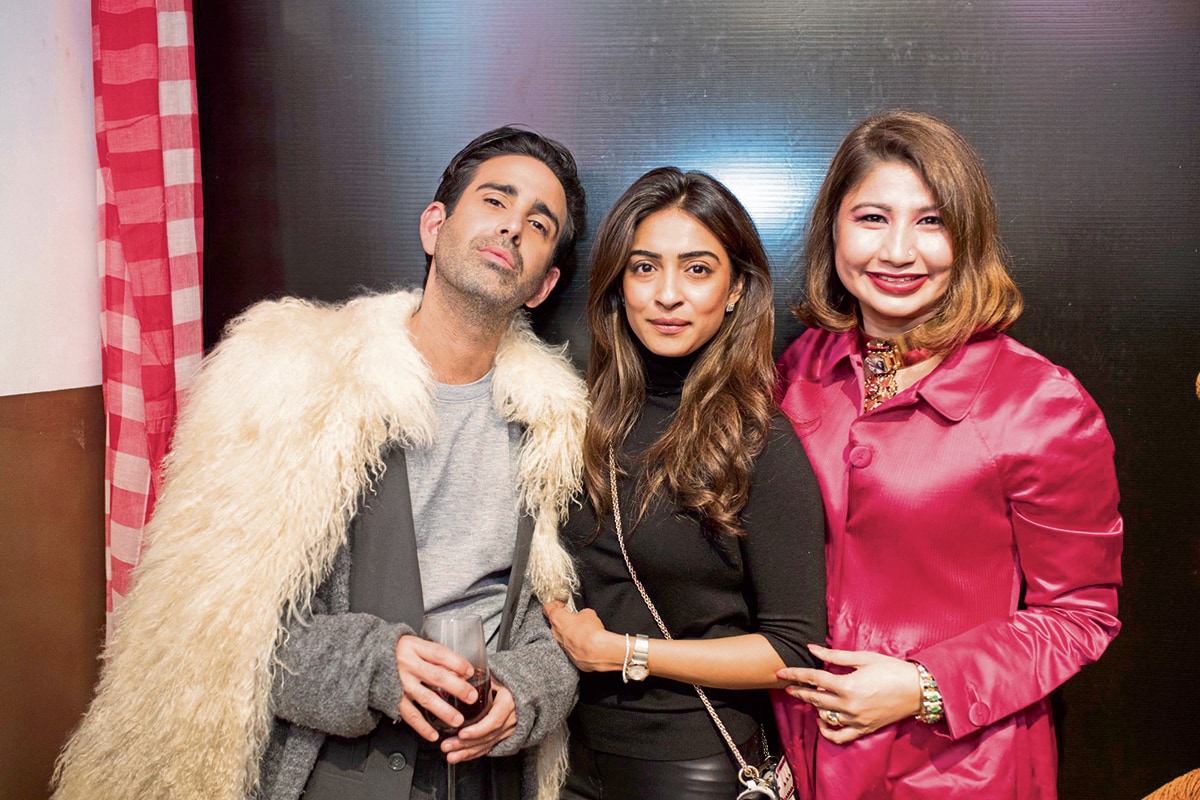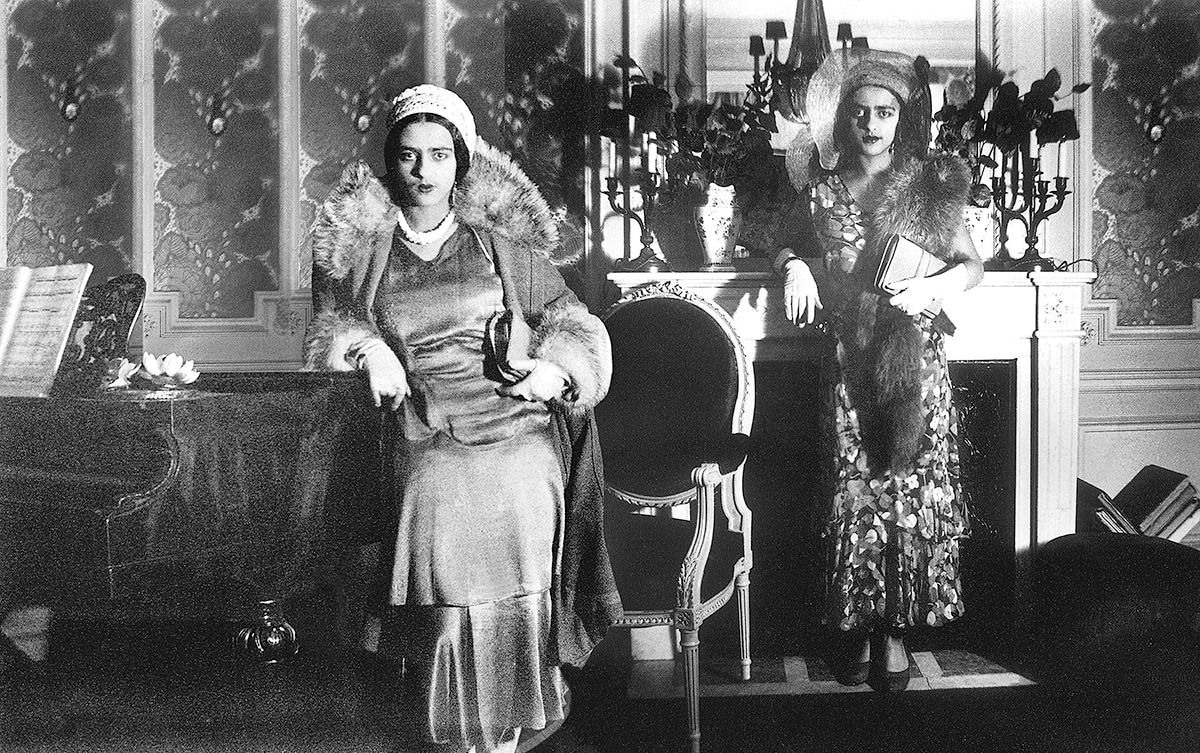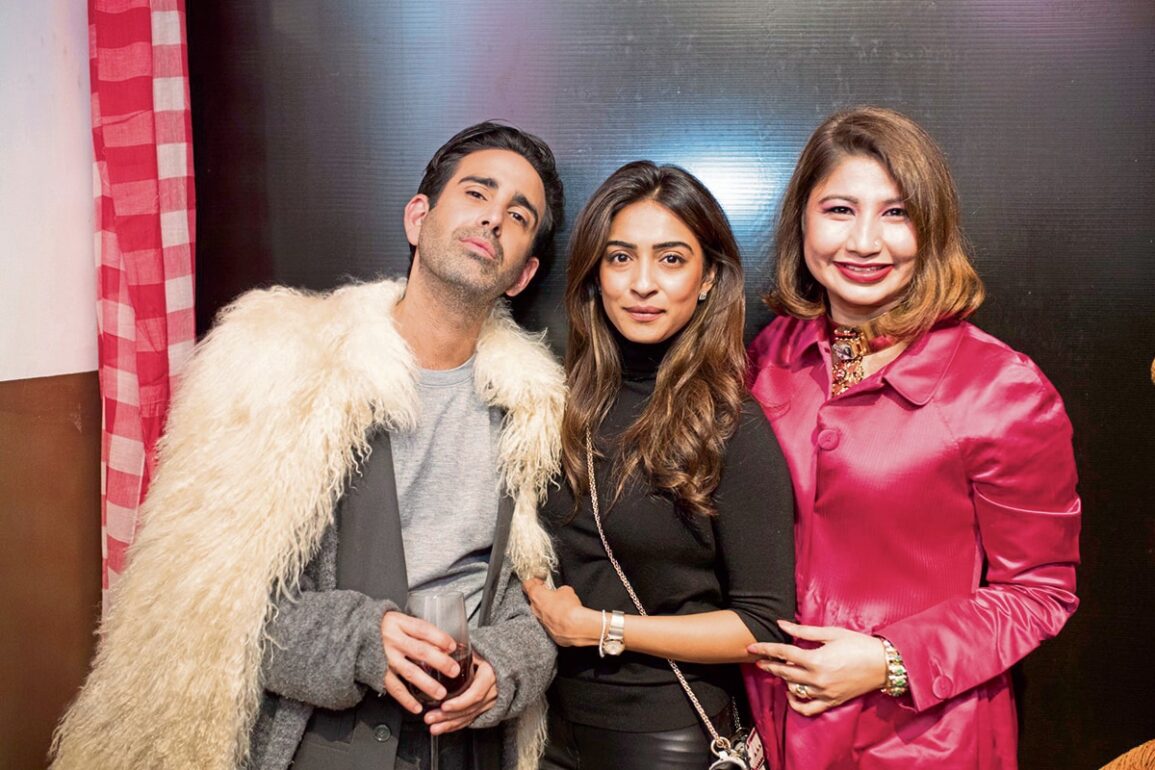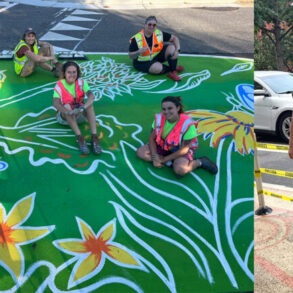Despite being on crutches, gallerist Bhavna Kakkar was in a beetle-red skirt and blouse with white polka dots, her short hair and bangs coloured red to resemble Self Portrait by Yayoi Kusama. Film producer Mozez Singh and businessman Shaurya Jain wore costumes inspired by Takashi Murakami’s A Homage to Monopink to the party held, incidentally, to raise funds for Unicef.
One of the most striking outfits turned out to be that of Greg Foster, creative director of Jaipur Rugs. Not a fan of dress codes, Foster was in an all-white Rajesh Pratap suit. He met France’s cultural attaché Amandine Roggeman on the lawn. She pulled out a banana and silver duct tape from her tiny Prada bag and stuck the banana near his right lapel, converting his suit into a hat-tip to Mauizio Cattelan’s Comedian (2019). “I can’t claim credit for it although it looks like I was the intelligent one,” Foster tells Lounge. He described the evening as “the Met Gala meets Bollywood Wives meets Marina Abramovic”.
It might sound like an evening of dedicated decadence, but art parties in India have become all about doing business. It’s at such parties that collectors, gallerists, patrons and artists chit-chat about the goings-on in the art world, forge connections and build networks, and pick up clues about hot artists to add to their collections. Parties hosted by wealthy collectors usually coincide with major art events, which include Delhi’s annual India Art Fair, the Kochi-Muziris Biennale and the newer Art Mumbai, which concluded recently.
An artist’s practice is private but you know he has arrived when his name is whispered at parties. “The art industry is interesting because there is such a community to it,” says Foster. “There is the absolute artistic side, the commercial side, the museum side and the cognoscenti. Art parties bring everyone together.”
A lot of business is conducted over soirees and dinners—and this is not just true for the art world but for any luxury and lifestyle commodity. According to Arvind Vijay Mohan, who heads the art market intelligence firm, Indian Art Investor, million-dollar transactions have been routinely discussed, negotiated and concluded over power lunches at the Georges and Caprices of the world. “In the global order, those whose intent it is to sell important pictures and objects—dealers as well as collectors—have used dinners, parties, galas to very successfully transfer the ownership of said artworks by the end of the night,” he says. The strictly-screened invitees include a mix of powerful curators, collectors and tastemakers, who ensure that the spotlit prizes are responded to favourably. “The art of transferring art objects in such a manner is a tad rudimentary yet in India, though there are some who have mastered this form,” he adds.
The party scene is driven largely by patrons and collectors, with the events being a declaration of intent—that the hosts are stakeholders and key players, even influencers, if you will, who steer the art world. Their patronage can dictate prices, trends, collaborations, and even the environment in which business is done. “The collectors, in some sense, have become the arbiters of space, a role which was held by the art critic earlier,” says critic Meera Menezes, who has chronicled key moments and encounters at many art events, including parties held by Kiran Nadar Museum of Art’s chairperson Kiran Nadar.
Her photo archive consists of candid shots of Indian art stalwarts such as Nalini Malini, Vivan Sundaram, Arpita Singh and Nilima Sheikh during parties. “The influence and sway of collectors who promote a certain kind of art in tandem with the rise of social media and influencers have led to people consuming art through images of events and not through engagement with critical texts. This has contributed to the decline of art criticism,” says Menezes. Art parties flash the temperature of the art world, that the fever is running high. All artists know that an invitation to art parties is a reflection of their success and their place in the pecking order, and they treat it like a necessary ordeal. Yet, parties also become inspiration for artists, who have revealed the psychological traps and anxieties of social interaction through some of their works.
In Arpita Singh’s People Around the Table (1993), a naked woman is ignored by people at the table covered with fruit, bread and decanters of drink. Ratheesh T.’s Opening (2023) reveals social awkwardness through a man in a mundu with wings and a beak, capturing both the discomfort of the host reeling under the prejudices of others, while also stereotyping guests. In contrast, we view conviviality, yearning and lust at Salman Toor’s depictions of gatherings of queer men in green rooms from his series I Know a Place, displayed at Nature Morte in 2019. Gurjeet Singh creates an imaginary party in which he uses gleaned fabric and stitches Bhupen Khakhar on a spree with Singh and his friends. The work, titled Party with Bhupen Khakhar, 2023, is inspired by anecdotes about Khakhar that Singh had heard from Atul Dodiya.

View Full Image
CELEBRATION SEASON
The Capital lights up January onwards, with soirees and gatherings leading up to the India Art Fair. Jaya Asokan, India Art Fair director, says that parties at this time exemplify the uniquely dual nature of these gatherings—as both social and professional spaces. On the one hand, they provide a relaxed setting for artists, curators and patrons to exchange new ideas and discuss trends, on the other, these events serve as informal forums where collections and acquisitions are discussed, feedback is shared and new connections are formed. “While the more formal programming during the day focuses on exhibitions, talks, and panel discussions, these evening gatherings encourage more candid engagement,” she says.
Also read: And the 2024 bride wore ‘very demure, very mindful’ make up
One of the major parties timed with the India Art Fair is the TAKE party hosted by Bhavna Kakar, founder of the art gallery, Latitude 28. She also helms the contemporary art biannual TAKE on Art magazine. Since its inception in 2009, the publication has hosted the inaugural party for the fair, while also launching the magazine’s latest issue and the collectible TAKE Edition. “Far from a conventional gathe ing, the TAKE Party has become a vibrant melting pot of voices, bringing together a mix of collectors, artists, gallerists, designers, art dealers, auction houses, critics, museum directors, and more,” elaborates Kakar. “This carefully curated guest list transforms the event into an informal yet buzzing networking ground.”
In the past, it has been hosted at hip venues across Delhi, with attention being paid to themed outfits and curated menus led by celebrated chefs such as Sujan Sarkar, Dhruv Oberoi, Vaibhav Bhargava, and Sanjeev Kapoor. According to Kakar, beyond its glamour, the TAKE Party fosters meaningful conversations that go far beyond the evening itself.
When Art Mumbai opened last year, it was marked by a series of parties. Sunita Choraria, art patron and Foundation for Indian Contemporary Art (FICA) board member, hosted one at her house as did director Karan Johar, who was Art Mumbai’s cultural ambassador. “Art Mumbai established their presence by making sure there were three-four parties by important collectors,” says Foster. “It is a statement that they had the support of the collectors.”
INFORMAL GALLERY
“There are very few public spaces in India that exhibit contemporary art in all its glory,” says Tarana Sawhney, who hosts a party every year to coincide with the India Art Fair. “Every year, I attempt a 30% rehang of our collection. Along with the old masters and the antiques, when you display contemporary art, you see a connection between the old and the new,” says Sawhney, a FICA board member. At one of her parties, an international museum acquired works by an emerging artist whose art was displayed prominently in her house, she says but refuses to divulge names. Sawhney describes her parties as an “extension of my art patronage” and hosts them on the lawn and across the floors of her Delhi home. “There is music, there is dance, there is madness,” says Sawhney. “You get to experience the entire art ecosystem in one evening.”
Over the last few years, her curation has tended towards public art. Last year, her house was covered in polka dots that could be read as a reference to Yayoi Kusama’s dots or Bharti Kher’s bindi. “I think about how to use my private space to go beyond what is in my collection. I try to bring a feature inspired by South Asian art to the decor.” Foster describes it as “the best art party” he has been to in India, apart from the MASH Ball. “The scenography of Tarana’s party was spectacular, absolute bonkers,” says Foster. “And Shalini’s idea of everyone being dressed up was outstanding. To see artistic expression through fashion was great. Everybody let their hair down.”
Also read: Sajan Mani’s act of history making

View Full Image
Oscar Wilde would have said that what’s worse than being invited to a party is not being invited— and this certainly applies to these tightly curated events with selective guest lists. Kiran Nadar and Lekha Poddar host sit-down lunch parties, their collections on display. Nadar’s garden parties have a guest of honour who makes a speech every year. Past guests of honour include Boon Hui Tan, former director of Asia Society Museum in New York, and Maria Balshaw, director of Tate Modern.
Passi is particular about who she has at her annual party on the lawn of her Delhi home. In 2019, Passi hosted a site-specific performance party titled Lunch is Cancelled, performed by artist Mithu Sen exploring the theme of ‘radical hospitality’. The work examined the nature of the relationship between guest and host and involved the in-house staff, the catering team members, Passi’s pug, his caretaker, and the Rajputana Rifles band of musicians. It raised questions about the hierarchies that shape society and institutions. Sen walked onto the lawn, followed by the band and servers wearing pet cones around their necks. “Those in the procession then sat down at a table and ate with their hands, aiming food, sometimes unsuccessfully, at their mouths,” explains Passi.
“A great art party is when it’s at somebody’s house and you see a curated private collection,” says Foster, whose dream parties include those thrown by American collector Peggy Guggenheim, model Tina Chow and Chicago-based artist Theaster Gates. “These parties make globally important people from the art world think that Delhi is fun, and we will be back next year.” Opening up a house and a collection can lead to conversations that spark the creative process. Photographer Gauri Gill saw a work by New York-based printmaker Zarina in Sawhney’s house during the annual party and suggested that Sawhney buy two of her own works that could be grouped with it. “The two works acquired by Tarana, Waterwells and Schoolyard, are very much about specificity of place and belonging. Zarina’s work is untitled, but in general her practice engaged with those concerns,” says Gill.
It is an unusual grouping at first sight but a close reading of subtexts makes it seem right: Zarina’ relief print made from collaged wood gives an impression of a barricade and Gauri Gill’s black-and-white photographs of swathes of desert land strewn with possessions summon ideas of absence and abandonment. Sawhney says this grouping is commented on quite frequently at her parties now.
BAITHAKS TO DJ NIGHTS
In the 1970s, musicians, painters, theatre performers and other artists would come together for informal gatherings, or addas. Mumbai-based gallery Chemould Prescott Road, for instance, has hosted all sorts of parties in its 60 years of existence, which in a way reflect the trajectory of the art world. When the gallery turned 25 in 1988, its founders Kekoo Gandhy and Khorshed Gandhy booked the Ripon Club at Fort for a good old adda. Their granddaughter Atyaan Jungalwala, co-founder of Chemould Colab, describes the venue as “an oldtime ‘bawaji club’ with planter chairs, long tables and old portraits that look inquiringly at their modern-day guests.”
Also read: Enjoy year-end parties without social burnout. Here’s how
Yet, the party was such a hit that the club became their regular spot for opening parties. By the time the gallery turned 50 in 2013, an old club was no longer enough for the art ecosystem’s finest. For this milestone, the gallery hosted a sit-down dinner for 150 people at Malini and Rahul Akerkar’s fine-dining restaurant Tote. “For all those we could not fit into the dinner, we followed it with an afterparty with the DJ and the works,” says Jungalwala.
Last year, its 60th anniversary party was a bash at Abhay Maskara’s capacious Gallery Maskara in Mumbai. In the warehouse-like space was displayed the monumental, three-dimensional mural Reclaiming the Inner Space by N.S. Harsha, made with thousands of carton boxes and wooden elephants crawling over the cosmos stuck on the boxes. The centrepiece lent to the atmosphere of the party heightened by the presence of a DJ, bar, food from Bombay Canteen and a speech by author Shobhaa De.

View Full Image
Asokan feels that the changing nature of the art gathering is reflective of the changing nature of the Indian art ecosystem itself. The informal baithaks of the 1970s-80s were conversational gatherings, which thrived on cross-disciplinary exchanges. Artists would come together to share ideas, critique each other’s work and celebrate the creative spirit. These gatherings were unstructured, almost serendipitous, with a focus on camaraderie rather than transactional goals.
During the early years of Vadehra Art Gallery, which was established in Delhi in 1987, artists Ram Kumar, M.F. Husain, Tyeb Mehta and S.H. Raza would sit there for hours, engrossed in discussions over cups of tea and plates of samosas. “There took place a sharing of ideas about art, poetry, politics, films, current events, interspersed with doses of gossip , as well as critiques of each other’s work,” shares Parul Vadehra, director of the gallery. Larger gatherings at the gallery for exhibition openings and events also had a similar ambience—a small circle that knew each other well and shared a lot of camaraderie.
“The gatherings were informal as the art ecosystem was very informal,” says Renu Modi, director, Gallery Espace. In the 1970s, she would host evening soirees with artists such as Husain and Krishen Khanna. She recalls hosting a sculpture artist from Gwalior, Joejo. “I wanted to introduce him to the art world. I displayed his sculptures across my garden, and hosted a Sunday lunch. Stalwarts such as J. Swaminathan, Manjit Bawa and Krishen Khanna came for the party to encourage a young emerging artist,” she says. Husain once said that Modi’s parties were among the few places where even people who did not see eye to eye would congregate.
Baithaks and discussions have transformed into curated walkthroughs at galleries. The ecosystem has become more formal now. There is a wider range of guests in attendance, including students and enthusiasts. Asokan explains that art parties remain spaces for dialogue, but “there is now a more curated lens through which these settings support and push the boundaries” of artistic engagement. “Parties of today vibrantly embrace creative curiosities and offer a space for experimentation,” she adds. Ultimately, though, an art party is the barometer of the art scene. “If there was nothing to celebrate, there wouldn’t be any parties. So it is a measure of success,” says Foster. If there were no parties, I think everybody would be a bit worried.”

View Full Image
THE PERFECT GUEST
Amrita Sher-Gil, who ushered in her own style of modernism, loved a good party. She enjoyed socialising, music and dancing, and collectors, gallerists, artists and other guests considered her the ideal party guest. It was such a large part of her persona that in Vivan Sundaram’s Retake of Amrita series (2001), one of the works is of Sher-Gil dressed for a night out in furs with white gloves and a clutch (in picture, below). Yashodhara Dalmia’s Amrita Sher-Gil: A Life (2013) details the hectic social life of the artist, which included meeting Jawaharlal Nehru at parties, which led her father to speculate that their relationship could perhaps lead to marriage. Dalmia also mentions Judy Chicago’s path-breaking work The Dinner Party featuring a table in the shape of an equilateral triangle with 39 plates celebrating remarkable women, real and mythical. Dalmia writes, “Among these, Amrita Sher-Gil’s name could be added for her inventive and allegorical works which focused on the lives of women.”
FROZEN IN TIME
Parties can have historical value: Pablo Bartholomew’s photos of party scenes from the 1970s can now be viewed as capturing a moment of social change and urbanisation. His Nommie Dancing at a Party at Koko’s (1975), Hanging Out (1978) or The Dance Room (1980) provide a glimpse of urban men and women in saris and bell-bottoms chilling and swaying to music. These are candid shots telescoping an era, a certain class of people and their outlook
Avantika Bhuyan contributed to this story.
Shweta Upadhyay is an arts journalist and co-author of I’ll be Looking at The Moon but I’ll Be Seeing You.
This post was originally published on this site be sure to check out more of their content








